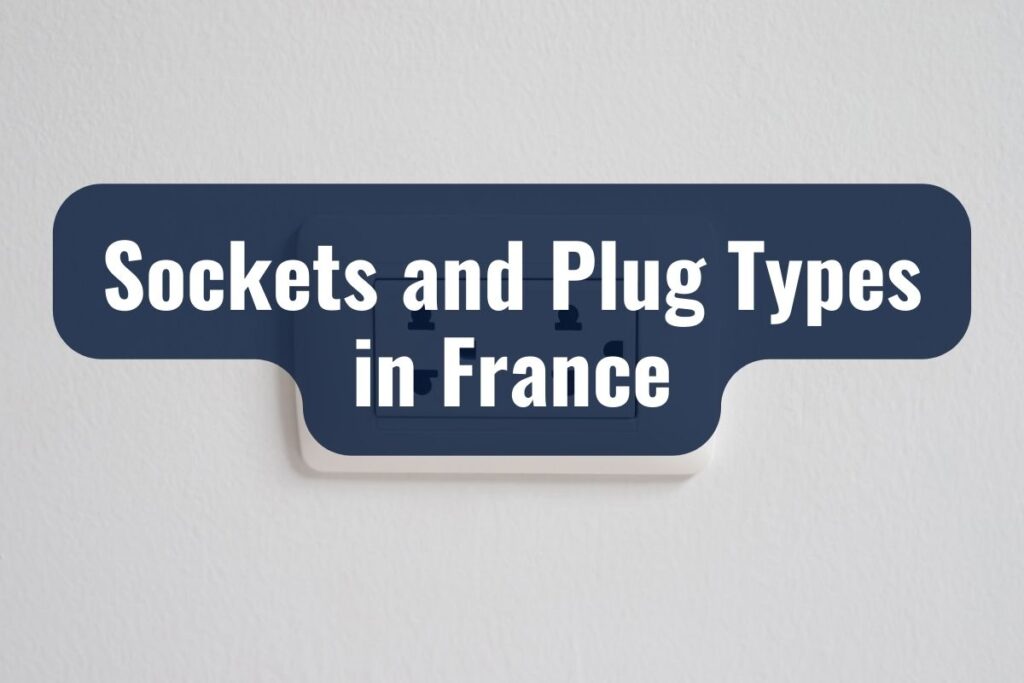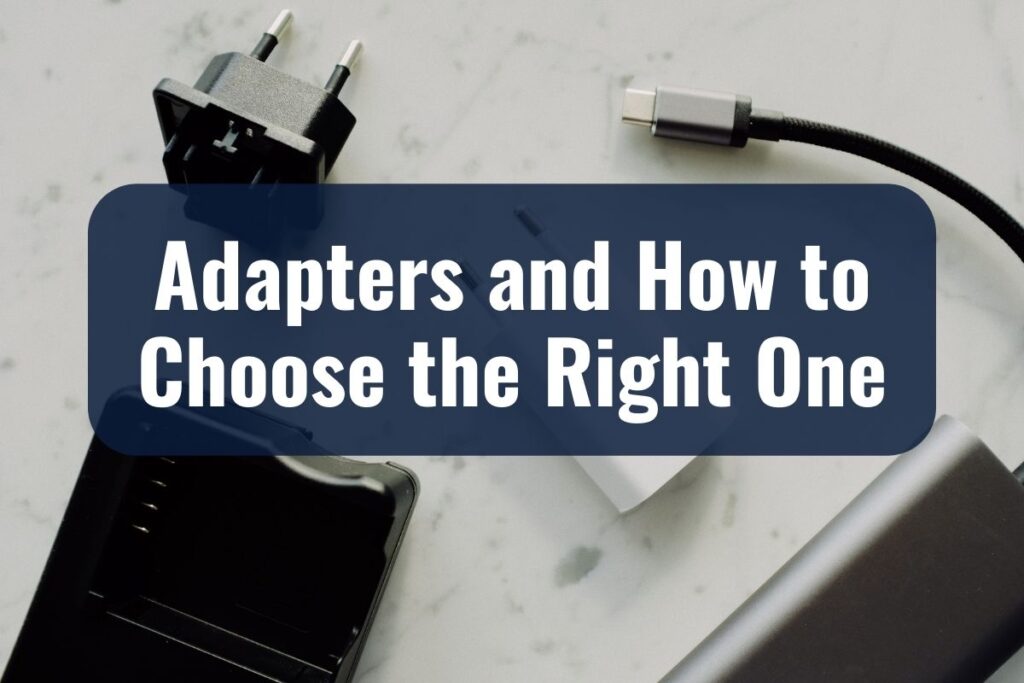Among the essential details to navigate daily life in France is a thorough understanding of the country’s electrical system—specifically, the types of plugs and sockets that power everything from smartphones to kitchen appliances.
For foreigners, managing electronics in a new country can be more than just a trivial concern—it is about staying connected with loved ones, maintaining daily routines, and ensuring a smooth transition into French living.
Whether you’re setting up your new abode or just passing through, the need for the right plug to charge your life cannot be overstated. This guide delves into the specifics of the French electrical grid, shedding light on the standard plug types in France, voltage requirements, and the intricacies of adapters to ensure that your transition is as seamless as the French silk.
KEY TAKEAWAYS
- France uses Type E sockets with a voltage of 230V and a standard frequency of 50Hz.
- Appliances not designed for 230V require a voltage converter or transformer for safe operation in France.
- Choosing the right adapter involves ensuring compatibility with Type E sockets and verifying grounding and certification.
- Safety with electronic devices includes checking device specifications, using quality adapters, and avoiding overloading.
- Adapters can be purchased at electronics stores, supermarkets, travel shops, online, hardware stores, and some pharmacies in France.
- Special considerations for using electronics in France include attention to the settings in historical buildings, rural areas, and peak travel seasons.
Understanding French Electrical Standards
Delving into the electrical standards in France, it’s essential to comprehend the foundation upon which the country’s power system is built. The currents of history have seen the French electrical infrastructure evolve significantly, culminating in a modern and efficient system that ensures a steady and reliable power supply to households and businesses alike.
The contemporary standards that dictate the French electrical system are reflective of a harmonized European approach. These regulations ensure that the power infrastructure is not only safe but also consistent across the country. In France, the alternating current (AC) is the norm, and the supply frequency stands at the European standard of 50 hertz (Hz). This rhythm of electrical current is a dance that all electronic devices must follow to operate effectively within the borders of France.
The voltage, another critical aspect of the power system, is where France, like much of Europe, has drawn a line at 230 volts (V). This voltage represents the potential difference delivered to electrical outlets and is a key figure to bear in mind when plugging in any appliance. It’s a robust level of power, designed to efficiently drive everything from the smallest charging device to the largest household appliance.
Understanding these standards is not just an academic exercise—it’s a practical necessity. The voltage and frequency set the stage for what type of electrical devices can be used and how they are used. For those used to a system operating at a mere 110-120 volts, as found in North America and some other regions, this difference can pose a significant adjustment. It’s the reason why a hairdryer from across the Atlantic might not only refuse to work but could potentially become damaged when introduced to a French socket.
Sockets and Plug Types in France

In the landscape of French electrical fittings, the plug type that reigns is unmistakably the Type E. Characterized by two round pins and a hole for the earth pin, this plug has become synonymous with French electrical outlets. Its design is thoughtful, ensuring a connection that is both secure and grounded, a testament to the safety standards that France upholds.
Type E
The Type E socket accommodates a male earthing pin, a feature that distinguishes it from its European cousins and adds an extra layer of safety. This design is meticulously engineered to fit seamlessly with the corresponding plugs, creating an electrical ecosystem that prioritizes protection against shocks.
For visual connoisseurs, the Type E plug presents a simple elegance. The two pins stand 19 mm apart, each with a diameter of 4.8 mm, poised above the socket’s earth pin, ready to deliver power to devices. The sockets themselves are recessed, which means the plug is partially inserted into the socket before making an electrical connection. This detail, while subtle, is a design dedication to minimizing exposure to live parts and ensuring that the act of plugging in is as safe as possible.
Type C
Yet, this is not the sole inhabitant of the French electrical habitat. In some older buildings and areas, you might still encounter the Type C plug, colloquially known as the “Europlug.” This is a non-grounded cousin, and while it is compatible with Type E sockets, it lacks the additional safety feature of the earthing pin.
Type F
It is also worth noting that, in rarer cases, you may come across outlets designed for the Type F plug, also known as “Schuko,” common in neighboring Germany. These sockets are designed to accept both Type E and Type F plugs, showcasing the versatility that is often seen within European electrical systems.
The presence of these different plug types underscores a historical journey of electrical standards in France. While the Type E is now the standard bearer, these other plug types are a reminder of the country’s transition through different eras of electrical innovation.
Voltage Considerations
Amidst the historical streets and modern allure of France, the voltage running through the veins of its power system presents a narrative of its own. At a potent 230 volts, the French voltage stands robust, prepared to energize everything from the essential coffee machine in the morning to the lamp that illuminates pages of a novel at night.
For a foreigner, this figure is not merely numerical but a fundamental aspect of daily life, defining how their electronic devices will interact with the French power grid. The standard voltage in France is considerably higher than the 110-120 volts common in North American territories and some Latin American countries. This variance is not just a matter of number but functionality and safety.
The implication of this difference is stark; appliances designed for lower voltage systems cannot simply be plugged into a French outlet and expected to perform. At best, they may operate inefficiently; at worst, they can overheat, potentially causing damage to the device or posing a fire risk.
To bridge this gap, voltage converters enter the scene, acting as translators between the appliance and the power source. These converters adjust the 230 volts down to a level compatible with the device, allowing safe operation. However, not all devices require a converter—many modern electronics come with dual voltage capabilities, meaning they can handle a range from 110 to 240 volts. For these worldly devices, a simple plug adapter may suffice, as they are already equipped to converse with the higher voltage.
Foreign residents and visitors alike should thus survey their electronic companions before embarking on their French journey. Checking the voltage compatibility of each device is a prelude to ensuring their seamless operation upon arrival. This due diligence is particularly crucial for high-power devices, such as hair dryers and irons, which not only demand substantial power but are also more prone to the consequences of voltage incompatibility.
Adapters and How to Choose the Right One

In the pursuit of harmonious living within the French electrical landscape, the adapter emerges as a crucial player. It serves as the intermediary, the piece that reconciles the differences between foreign plugs and French sockets, ensuring that devices from afar can draw power from this land’s unique energy tapestry.
The selection of the right adapter is not a decision to be taken lightly, for it affects not just the convenience of charging one’s devices, but also the safety of their operation. An adapter does not convert electricity; it merely allows a plug to fit into a foreign socket. As such, it is important to choose one that does not compromise on safety standards or the integrity of the device it serves.
When seeking out the right adapter, one should be on the lookout for several key features:
| Feature | Description | Importance |
| Type E Compatibility | Adapters must fit the French recessed Type E sockets. | Essential |
| Grounding Mechanism | Adapters should provide grounding for safety. | Essential |
| Build Quality | Durable construction to withstand frequent use. | Highly Recommended |
| Certification Marks | Look for the CE mark or other safety compliance indicators. | Highly Recommended |
| Additional Ports | Having USB ports allows charging multiple devices. | Convenient |
Compatibility with Type E Outlets: The adapter should be tailored to fit the recessed Type E sockets predominantly found in France, ensuring a snug and secure connection.
Accommodation of Grounding: Given that the standard French plug includes an earthing pin for additional safety, the ideal adapter should also provide a grounding mechanism.
Robust Construction: A well-built adapter will resist damage from frequent use, which is especially important for those who plan an extended stay or frequent travel.
Certification Marks: Look for adapters that carry a CE mark, indicating that the product complies with European safety standards. Other certification marks that denote safety compliance can also be reassuring.
For those whose devices are already equipped to handle 230 volts, the adapter is all that is needed. However, for others, particularly those carrying single-voltage devices from countries with lower standard voltages, an adapter may need to be paired with a voltage converter or transformer.
In choosing the appropriate adapter, there is also a choice between universal adapters and single-region adapters. While universal adapters offer versatility, covering plug types from multiple regions, single-region adapters are specifically designed for the plug type they serve, which can often result in a more reliable fit.
Lastly, it is worth considering adapters that come with additional features such as USB ports, which allow for the charging of multiple devices simultaneously. This can be particularly convenient for those with several devices or for those living in accommodations with limited outlets.
Safety Tips for Using Electronic Devices in France
To maintain the integrity of your devices and your own well-being, here are several safety tips that should be adhered to while using electronic devices in France:
- Check Device Specifications: Before plugging in, always check your device’s compatibility with the 230V and 50Hz electrical supply in France. This information is typically found on the device’s power adapter or within its manual.
- Use Quality Adapters and Converters: Opt for adapters and voltage converters that have safety certifications and robust build quality. Skimping on quality for these essential accessories can be a false economy and a safety risk.
- Avoid Overloading Adapters: Do not plug too many devices into a single adapter, particularly high-wattage appliances, as this can cause overheating and potentially lead to a fire.
- Unplug When Not In Use: As a precaution, unplug your devices when they are not actively being used or when you are away from your residence. Not only does this save energy, but it also minimizes any risk of overheating or power surges damaging your devices.
- Inspect Cords and Plugs Regularly: Check for any damage or wear on the cords and plugs of your devices. Frayed wires or cracked plugs can expose you to electric shocks or cause short circuits.
- Keep Away from Water: This universal rule of electrical safety is particularly pertinent in France. Ensure all electrical devices are used away from water to avoid the risk of electric shock.
- Be Mindful of Heat Emission: Electronic devices can generate heat, especially when plugged in for extended periods. Ensure they are well-ventilated and kept away from flammable materials.
- Consult Local Experts for Major Appliances: If you are unsure about the compatibility of major appliances with the French electrical system, seek advice from local experts before attempting to connect them to the power supply.
Where to Buy Adapters in France

Navigating the French landscape, with its cobblestone streets and modern amenities, one may find themselves in need of an adapter to bridge the gap between their electronic devices and the French electrical system. Fortunately, France offers a variety of options for purchasing the right adapter, ensuring that you can keep your devices charged and ready to use throughout your stay.
Electronics Stores: Specialist electronics retailers are scattered liberally across France, from major chains to independent boutiques. These stores typically offer a wide range of adapters and are staffed with knowledgeable personnel who can provide advice on the best type for your needs.
Supermarkets and Hypermarkets: Larger supermarkets, as well as hypermarkets, usually have a section dedicated to electrical goods. Here, you can find a selection of adapters at reasonable prices, allowing you to pick one up during your regular shopping trips.
Travel Shops and Airports: For those who realize their need for an adapter upon arrival or are preparing for departure, travel shops in airports and train stations often stock adapters. While convenient, it’s worth noting that prices in such locations can be higher than average.
Online Retailers: With a wealth of online shopping options available in France, you can easily order an adapter from retailers like Amazon.fr or Cdiscount and have it delivered directly to your accommodation.
DIY and Hardware Stores: French “bricolage” stores, or hardware stores, often carry a range of electrical accessories, including adapters. These are ideal places to find more durable and specialized types that may not be available in general stores.
Pharmacies: Some larger pharmacies in France offer more than just medical supplies, including travel essentials like adapters. This can be especially convenient if you’re in need of an adapter quickly.
When purchasing an adapter, it’s important to ensure that it is suitable for the type of device and the power specifications of your home country. If in doubt, don’t hesitate to ask for assistance. Sales staff are usually more than willing to help ensure that you make the correct purchase.
Related: Electronic Stores in France: Guide to Buying Electronics
Special Considerations
When immersing oneself in the vibrant culture and daily life of France, there are additional nuances to consider regarding the use of electronic devices. These special considerations ensure that one’s experience with French electricity is not only seamless but also tailored to the unique aspects of living or traveling in this country.
- Historical Buildings: In the heart of France’s many historical regions, the electrical infrastructure in older buildings may not have been updated to current standards. In these charming but aged edifices, the electrical wiring can be delicate, and power surges are more common. It is advisable to use a surge protector when charging valuable devices to prevent damage.
- Rural Areas: While urban areas will have a consistent electrical supply, more rural or isolated locations might experience variations in voltage or occasional outages. Be prepared with backup power solutions, such as power banks, particularly if relying on electronic devices for navigation or communication.
- Travel Season: During peak travel seasons, the demand for adapters and converters can soar, potentially leading to shortages in stores. Plan ahead and purchase your adapter before the travel season hits or soon after arriving in France.
- Antique or Specialized Electronics: If you are bringing antique or specialized electronic equipment to France, consult with an electrician or a specialist retailer. Such devices may have specific power requirements that standard adapters and converters cannot meet.
- French Extension Cords: When using an adapter, you may also need an extension cord if the outlet is not conveniently located. French extension cords are designed to fit the safety and electrical standards in place, so it’s wise to use these rather than bringing one from abroad.
- Multiple Appliances: If you intend to plug in several devices at once, consider purchasing a power strip with multiple outlets that is rated for use in France. This will allow you to use several devices while only requiring one adapter and will ensure that the power strip manages the load appropriately.
- Leisure Vehicles: Those traveling with leisure vehicles, such as motorhomes or caravans, should be aware that the electrical systems in these vehicles may require specific types of adapters and connectors, often different from those used in residential buildings.
Related: New to France: An Insightful Guide for Newcomers 2024


